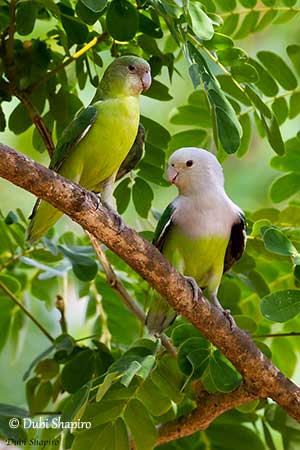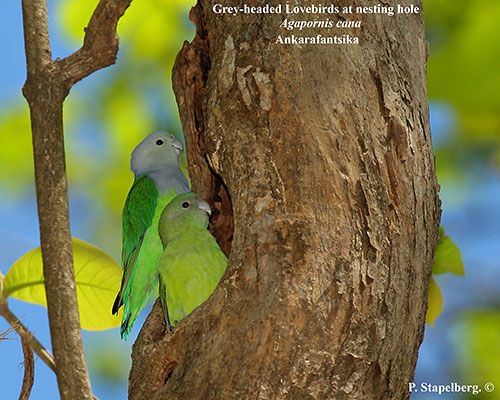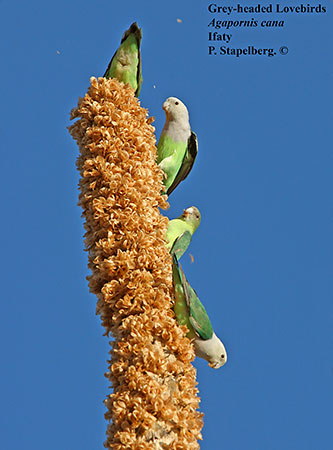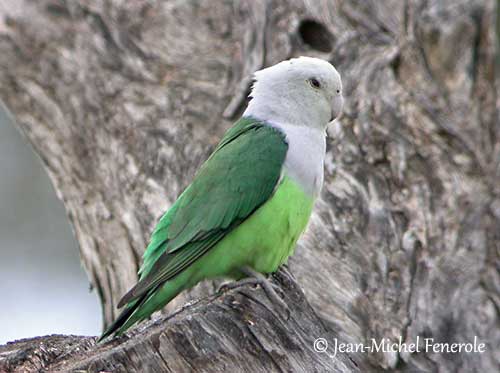
Fr: Inséparable à tête grise
Ang: Grey-headed Lovebird
All: Grauköpfchen
Esp: Inseparable Malgache
Ita: Inseparabile testagrigia
Nd: Grijskopagapornis
Sd: gråhuvad dvärgpapegoja
Mal: Fodindriaka, Karaoka, Kariaka, Kariga, Kitrehoka, Sarengy, Sarivazo
Photographers:
Jean-Claude Billonneau
Photographe-témoin de la Beauté du Monde
Jean Michel Fenerole
Photos d’Oiseaux du monde
William Price
PBase-tereksandpiper & Flickr William Price
Dubi Shapiro
Dubi Shapiro Photo Galleries
Philip Stapelberg
GALLERY
Text by Nicole Bouglouan
Sources:
HANDBOOK OF THE BIRDS OF THE WORLD vol 4 by Josep del Hoyo-Andrew Elliott-Jordi Sargatal - Lynx Edicions - ISBN: 8487334229
PARROTS OF THE WORLD – An Identification Guide – by Joseph M. Forshaw – Princeton University Press – ISBN 0691092516
HBW Alive
The Lovebird Handbook Par Vera Appleyard
Wikipedia, the free encyclopaedia
Grey-headed Lovebird
Agapornis canus
Psittaciformes Order – Psittaculidae Family
INTRODUCTION:
The Grey-headed Lovebird is endemic to Madagascar where it is widespread in lightly wooded habitats and cultivated areas. The species has been introduced in several Indian Ocean islands. Two subspecies share the island and are resident.
The Grey-headed Lovebird is considered to be the most primitive of the genus Agapornis, having been isolated on the island of Madagascar. It has much smaller bill than it is in other “lovebird” species.
The species is not globally threatened but it is now less common and even rare in some areas.
DESCRIPTION OF THE BIRD:
Biometrics:
Length: 13-15 cm
Weight: 25-28 g
The Grey-headed Lovebird adult male of nominate race has pale grey head, neck and breast. The upperparts are green with brighter rump. The tail is green with black subterminal bar on outer rectrices.
The underparts are yellow-green with black underwing-coverts.
The bill is greyish-white. The eyes are dark brown. Legs and feet are grey.

Unlike the male, the adult female has green head, neck and breast. She has more uniform green plumage overall, including the underwing-coverts. The upperparts are sometimes browner than those of the male.
The immature resembles female but it has yellowish bill with black base. The young male has the grey head suffused green.
SUBSPECIES AND RANGE:
The Grey-headed Lovebird has two subspecies.
A.c. canus (described above) occurs throughout Madagascar, except in SW.
A.c. ablectaneus is found in SW Madagascar, from R Mangoky to W side of Anosyenne Mts.
This race is darker green above and less yellow below. Head and breast of male are darker grey tinged blue.
The species (probably “canus”) has been introduced to Comoros, Seychelles, Reunion, Mauritius, Rodrigues, and also Zanzibar and other African locations. It persists only in Comoros.
HABITAT:
The Grey-headed Lovebird can be seen in lightly wooded habitats including savanna, semi-arid scrubland, forest edges and clearings, ricefields adjacent to disturbed woodland and settlements, towns and villages. It can be seen up to 1,000/1,500 metres, but it is mainly found at lower elevation.
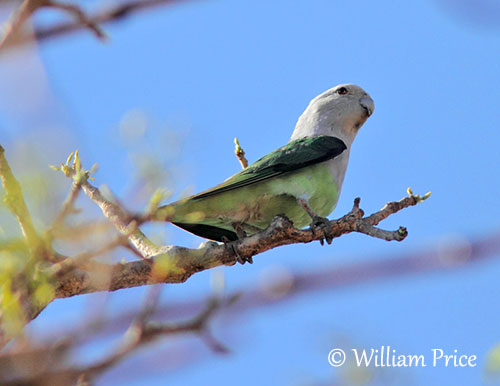
REPRODUCTION OF THIS SPECIES
The breeding season occurs between November-December and March in Madagascar, and between November and April in Comoros.
The Grey-headed Lovebird nests in tree holes, usually in dead trees such as Tamarindus, Acacia and other species. The cavity is lined with pieces of leaf, bark and grass finely chewed. The nest materials are carried by the female between her body feathers.
She lays 3-6 white eggs at one-day intervals. She incubates alone during 20-23 days (in captivity), starting with the second egg. The young fledge in about 44 days, but they are independent only two weeks later.
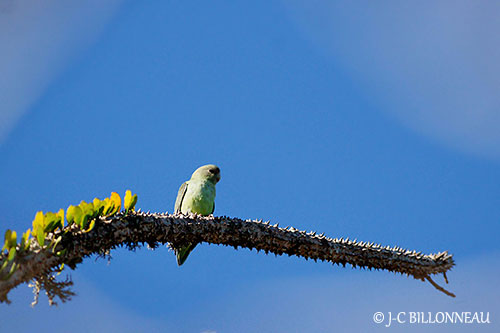
CALLS AND SONGS: SOUNDS BY XENO-CANTO
The Grey-headed Lovebird gives metallic “plee…plee…plee” in flight and at nightime roost. It utters varied whistles and squawks, and a subdued chattering. If alarmed, it gives a series of high-pitched notes.
BEHAVIOUR IN THE WILD:
The Grey-headed Lovebird feeds typically on fruits and grass seeds. It can be seen in large flocks at abundant food sources. It often feeds on the ground, but if disturbed, it rises up to a perch in the nearby vegetation. It returns soon to the ground.
They roost in dead, leafless trees where they are gregarious and noisy.
They nest in tree hole, often in dead trees. They are shy, both in the wild and in captivity.
The Grey-headed Lovebird is sedentary on the island.
The flight is direct and very swift.
